Three reasons, the first: guide coat is usually used to to fair the surface and not to remove scratches, at least in our work, I don’t know if someone would use it to remove scratches. We use guide coat in the dry phase, not in the wet since at the wet phase we’re within a few tens of microns in the precision of the part and we don’t have any surface imperfection. In the wet phase we’re trying to get rid of the marks of prior sanding to get a perfect surface.
The second: We use a very simple method to get an accurate layer thickness, we spray evenly on the entire surface based on material/surface area. Then both the base coat and top coats are sprayed in at least three layers of alternating colors (white and black). The topcoat has a layer of transparent on it too. When we sand, we know exactly how deep we have gone based on the color that emerges from the sanding. So we don’t use dusted type of carbon black guide coat. Our process itself guarantees the thickness and guides the sanding correctly.
the third: In wet sanding we use copious amounts of water and a bit of liquid soap in the water. This is to wash away any grit during sanding and also as a lubricant. Thus, if we’d botched up the dry sanding and wished to use wet sanding to fair or correct the surface and used carbon black as guide, it would get washed away with the first pass of the wet sanding paper. Mind you we’re not making small parts. I’m attaching a photo of the smallest part we have, this is a structural part which is not seen from outside. This is not an aesthetic part but we still have a close to mirror finish on it. It is black in color and the blue on the sides is the color of the door, the light blue is the sky and the green is the grass next to our facility’s fence. Here we stopped sanding at 800grit and its polished with duratec 1000 paste. Unfortunately, I’m not at the liberty to share other photos of the parts, but this should give you an idea of mirror finish on a part that will never see the light of day. On the actual surface parts you could easily comb your hair in the reflection. On this part you’ll see a reflection of the outside of our facility.
Hope this helps.











